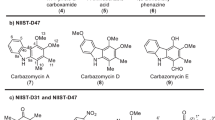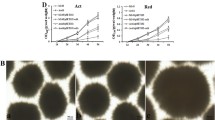Abstract
Streptomyces are ubiquitous soil bacteria well known for their ability to produce a wide range of secondary metabolites including antibiotics. In their natural environments, they co-exist and interact with complex microbial communities and their natural products are assumed to play a major role in mediating these interactions. Reciprocally, their secondary metabolism can be influenced by the surrounding microbial communities. Little is known about these complex interactions and the underlying molecular mechanisms. During pairwise co-culture experiments, a fluorescent Pseudomonas, Pseudomonas fluorescens BBc6R8, was shown to prevent the production of the diffusible blue pigment antibiotic γ-actinorhodin by Streptomyces coelicolor A3(2) M145 without altering the biosynthesis of the intracellular actinorhodin. A mutant of the BBc6R8 strain defective in the production of gluconic acid from glucose and consequently unable to acidify the culture medium did not show any effect on the γ-actinorhodin biosynthesis in contrast to the wild-type strain and the mutant complemented with the wild-type allele. In addition, when glucose was substituted by mannitol in the culture medium, P. fluorescens BBc6R8 was unable to acidify the medium and to prevent the biosynthesis of the antibiotic. All together, the results show that P. fluorescens BBc6R8 impairs the biosynthesis of the lactone form of actinorhodin in S. coelicolor by acidifying the medium through the production of gluconic acid. Other fluorescent Pseudomonas and the opportunistic pathogen Pseudomonas aeruginosa PAO1 also prevented the γ-actinorhodin production in a similar way. We propose some hypotheses on the ecological significance of such interaction.



Similar content being viewed by others
References
Bailey MJ, Lilley AK, Thompson IP et al (1995) Site directed chromosomal marking of a fluorescent pseudomonad isolated from the phytosphere of sugar beet; stability and potential for marker gene transfer. Mol Ecol 4:755–763
Barker WW, Welch SA, Banfield JF (1997) Biogeochemical weathering of silicate minerals. Rev Mineral Geochem 35:391–428
Bechet M, Blondeau R (1998) Iron deficiency-induced tetracycline production in submerged cultures by Streptomyces aureofaciens. J Appl Microbiol 84:889–894
Brockmann H, Hieronymus E (1955) Über Actinomycetenfarbstoffe, V. Mitteil. 1): Zur Konstitution des Actinorhodins, III. Mitteil1). Chem Ber 88:1379–1390
Bystrykh LV, Fernandez-Moreno MA, Herrema JK et al (1996) Production of actinorhodin-related “blue pigments” by Streptomyces coelicolor A3(2). J Bacteriol 178:2238–2244
Challis GL (2014) Exploitation of the Streptomyces coelicolor A3(2) genome sequence for discovery of new natural products and biosynthetic pathways. J Ind Microbiol Biotechnol 41:219–232
Chater KF (2010) Bacterial extracellular biology. FEMS Microbiol Rev 34:87–88
Coisne S, Béchet M, Blondeau R (1999) Actinorhodin production by Streptomyces coelicolor A3(2) in iron-restricted media. Lett Appl Microbiol 28:199–202
Compeau G, Al-Achi BJ, Platsouka E, Levy SB (1988) Survival of rifampin-resistant mutants of Pseudomonas fluorescens and Pseudomonas putida in soil systems. Appl Environ Microbiol 54:2432–2438
Davies J (2006) Are antibiotics naturally antibiotics? J Ind Microbiol Biotechnol 33:496–499
Davies J (2013) Specialized microbial metabolites: functions and origins. J Antibiot Tokyo 66:361–364
de Werra P, Péchy-Tarr M, Keel C, Maurhofer M (2009) Role of gluconic acid production in the regulation of biocontrol traits of Pseudomonas fluorescens CHA0. Appl Environ Microbiol 75:4162–4174
Deveau A, Brulé C, Palin B et al (2010) Role of fungal trehalose and bacterial thiamine in the improved survival and growth of the ectomycorrhizal fungus Laccaria bicolor S238 N and the helper bacterium Pseudomonas fluorescens BBc6R8: role of trehalose and thiamine in mutualistic interaction. Environ Microbiol Rep 2:560–568
Ditta G, Stanfield S, Corbin D, Helinski DR (1980) Broad host range DNA cloning system for gram-negative bacteria: construction of a gene bank of Rhizobium meliloti. Proc Natl Acad Sci 77:7347–7351
Duine JA (1991) Quinoproteins: enzymes containing the quinonoid cofactor pyrroloquinoline quinone, topaquinone or tryptophan–tryptophan quinone. Eur J Biochem FEBS 200:271–284
Eisenberg RC, Butters SJ, Quay SC, Friedman SB (1974) Glucose uptake and phosphorylation in Pseudomonas fluorescens. J Bacteriol 120:147–153
Fender JE, Bender CM, Stella NA et al (2012) Serratia marcescens quinoprotein glucose dehydrogenase activity mediates medium acidification and inhibition of prodigiosin production by glucose. Appl Environ Microbiol 78:6225–6235
Floriano B, Bibb M (1996) afsR is a pleiotropic but conditionally required regulatory gene for antibiotic production in Streptomyces coelicolor A3(2). Mol Microbiol 21:385–396
Frey-Klett P, Pierrat JC, Garbaye J (1997) Location and survival of mycorrhiza helper Pseudomonas fluorescens during establishment of ectomycorrhizal symbiosis between Laccaria bicolor and Douglas fir. Appl Environ Microbiol 63:139–144
Frey-Klett P, Chavatte M, Clausse M-L et al (2005) Ectomycorrhizal symbiosis affects functional diversity of rhizosphere fluorescent pseudomonads. New Phytol 165:317–328
Geng J, Yu S-B, Wan X et al (2008) Protective action of bacterial melanin against DNA damage in full UV spectrums by a sensitive plasmid-based noncellular system. J Biochem Biophys Methods 70:1151–1155
Gliese N, Khodaverdi V, Görisch H (2010) The PQQ biosynthetic operons and their transcriptional regulation in Pseudomonas aeruginosa. Arch Microbiol 192:1–14
Haas D, Défago G (2005) Biological control of soil-borne pathogens by fluorescent pseudomonads. Nat Rev Microbiol 3:307–319
Hanahan D (1983) Studies on transformation of Escherichia coli with plasmids. J Mol Biol 166:557–580
Holloway BW (1955) Genetic recombination in Pseudomonas aeruginosa. J Gen Microbiol 13:572–581
Janssen PH (2006) Identifying the dominant soil bacterial taxa in libraries of 16S rRNA and 16S rRNA genes. Appl Environ Microbiol 72:1719–1728
Kamilova F, Kravchenko LV, Shaposhnikov AI et al (2006) Organic acids, sugars, and L-tryptophane in exudates of vegetables growing on stonewool and their effects on activities of rhizosphere bacteria. Mol Plant Microbe Interact MPMI 19:250–256
Kaur R, Macleod J, Foley W, Nayudu M (2006) Gluconic acid: an antifungal agent produced by Pseudomonas species in biological control of take-all. Phytochemistry 67:595–604
Kieser T, Bibb MJ, Buttner MJ et al (2000) Practical streptomyces genetics. John Innes Fundation, Norwich, UK
Kim Y, Bae B, Choung Y (2005) Optimization of biological phosphorus removal from contaminated sediments with phosphate-solubilizing microorganisms. J Biosci Bioeng 99:23–29
Kovach ME, Elzer PH, Steven Hill D et al (1995) Four new derivatives of the broad-host-range cloning vector pBBR1MCS, carrying different antibiotic-resistance cassettes. Gene 166:175–176
Kraemer SM (2004) Iron oxide dissolution and solubility in the presence of siderophores. Aquat Sci Res Bound 66:3–18
Loper JE, Henkels MD (1999) Utilization of heterologous siderophores enhances levels of iron available to Pseudomonas putida in the rhizosphere. Appl Environ Microbiol 65:5357–5363
McCarthy AJ, Williams ST (1992) Actinomycetes as agents of biodegradation in the environment—a review. Gene 115:189–192
Miller SH, Browne P, Prigent-Combaret C et al (2010) Biochemical and genomic comparison of inorganic phosphate solubilization in Pseudomonas species. Environ Microbiol Rep 2:403–411
Mueller KE, Eissenstat DM, Hobbie SE et al (2012) Tree species effects on coupled cycles of carbon, nitrogen, and acidity in mineral soils at a common garden experiment. Biogeochemistry 111:601–614
O’Brien J, Wright GD (2011) An ecological perspective of microbial secondary metabolism. Curr Opin Biotechnol 22:552–558
Ochi K, Hosaka T (2013) New strategies for drug discovery: activation of silent or weakly expressed microbial gene clusters. Appl Microbiol Biotechnol 97:87–98
Onaka H, Mori Y, Igarashi Y, Furumai T (2011) Mycolic acid-containing bacteria induce natural-product biosynthesis in Streptomyces Species. Appl Environ Microbiol 77:400–406
Perez J, Munoz-Dorado J, Brana AF et al (2011) Myxococcus xanthus induces actinorhodin overproduction and aerial mycelium formation by Streptomyces coelicolor. Microb Biotechnol 4:175–183
Ponraj P, Shankar M, Ilakkiam D et al (2013) Influence of periplasmic oxidation of glucose on pyoverdine synthesis in Pseudomonas putida S11. Appl Microbiol Biotechnol 97:5027–5041
Ramette A, Frapolli M, Saux MFL et al (2011) Pseudomonas protegens sp. nov., widespread plant-protecting bacteria producing the biocontrol compounds 2,4-diacetylphloroglucinol and pyoluteorin. Syst Appl Microbiol 34:180–188
Rodriguez H, Fraga R (1999) Phosphate solubilizing bacteria and their role in plant growth promotion. Biotechnol Adv 17:319–339
Seipke RF, Kaltenpoth M, Hutchings MI (2012) Streptomyces as symbionts: an emerging and widespread theme? Fems Microbiol Rev 36:862–876
Sverdrup H, Warfvinge P (1995) Estimating field weathering rates using laboratory kinetics. Rev Mineral Geochem 31:485–541
Traxler MF, Watrous JD, Alexandrov T et al (2013) Interspecies interactions stimulate diversification of the Streptomyces coelicolor secreted metabolome. mBio 4:e00459–13
Uroz S, Calvaruso C, Turpault MP et al (2007) Effect of the mycorrhizosphere on the genotypic and metabolic diversity of the bacterial communities involved in mineral weathering in a forest soil. Appl Environ Microbiol 73:3019–3027
Uroz S, Calvaruso C, Turpault MP et al (2009a) Efficient mineral weathering is a distinctive functional trait of the bacterial genus Collimonas. Soil Biol Biochem 41:2178–2186
Uroz S, Calvaruso C, Turpault M-P, Frey-Klett P (2009b) Mineral weathering by bacteria: ecology, actors and mechanisms. Trends Microbiol 17:378–387
Uroz S, Oger P, Lepleux C et al (2011) Bacterial weathering and its contribution to nutrient cycling in temperate forest ecosystems. Res Microbiol 162:820–831
Watrous J, Roach P, Alexandrov T et al (2012) Mass spectral molecular networking of living microbial colonies. Proc Natl Acad Sci 109:E1743–E1752
Welch SA, Taunton AE, Banfield JF (2002) Effect of microorganisms and microbial metabolites on apatite dissolution. Geomicrobiol J 19:343–367
Wright LF, Hopwood DA (1976) Actinorhodin is a chromosomally-determined antibiotic in Streptomyces coelicolor A3(2). J Gen Microbiol 96:289–297
Yang Y-L, Xu Y, Straight P, Dorrestein PC (2009) Translating metabolic exchange with imaging mass spectrometry. Nat Chem Biol 5:885–887
Yim G, Wang HH, Davies J (2007) Antibiotics as signalling molecules. Philos Trans R Soc Lond B Biol Sci 362:1195–1200
Zhu H, Sandiford SK, van Wezel GP (2014) Triggers and cues that activate antibiotic production by actinomycetes. J Ind Microbiol Biotechnol 41:371–386
Acknowledgments
This work was founded by the French National Research Agency through the Laboratory of Excellence ARBRE (ANR-11-LABX-0002-01), by the French National Institute for Agricultural Research (INRA) and Région Lorraine. JG was supported by a CJS (Contrat Jeune Scientifique) Grant from INRA. We thank Jean-Selim Medot for his help in this work.
Author information
Authors and Affiliations
Corresponding author
Additional information
Communicated by Matthias Boll.
Electronic supplementary material
Below is the link to the electronic supplementary material.
Rights and permissions
About this article
Cite this article
Galet, J., Deveau, A., Hôtel, L. et al. Gluconic acid-producing Pseudomonas sp. prevent γ-actinorhodin biosynthesis by Streptomyces coelicolor A3(2). Arch Microbiol 196, 619–627 (2014). https://doi.org/10.1007/s00203-014-1000-4
Received:
Revised:
Accepted:
Published:
Issue Date:
DOI: https://doi.org/10.1007/s00203-014-1000-4




